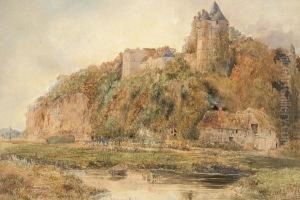Frederick Whymper Paintings
Frederick Whymper was a British artist and explorer known for his travels in the North American and Arctic regions during the nineteenth century. Born on August 26, 1838, in London, England, Frederick was part of the Whymper family, which included his brother Edward Whymper, a renowned mountaineer who famously made the first ascent of the Matterhorn.
Frederick Whymper's career began in the field of illustration and wood engraving. He had an artistic flair, which he combined with his adventurous spirit. In the 1860s, he traveled to British Columbia and Alaska, drawn by the allure of the unexplored territories and the potential for artistic inspiration. During this period, he participated in several significant expeditions, including the Russian-American Telegraph Expedition, which aimed to establish telegraphic communication between America and Europe via the Bering Strait.
Throughout his travels, Whymper sketched and documented the landscapes, indigenous peoples, and wildlife of the regions he explored. His illustrations served as valuable records of these areas during a time when photography was still in its infancy for field documentation. Whymper's work was featured in various publications, which helped to introduce the wider public to the remote and rugged beauty of the North American frontier.
Aside from his artistic contributions, Frederick Whymper was also an author. He penned a book titled 'Travel and Adventure in the Territory of Alaska,' originally published in 1868, where he narrated his experiences and observations during his travels in Alaska when it was still known as Russian America. The book remains an important historical account of the region during that era.
Frederick Whymper's life was one of curiosity and exploration, blending his artistic talents with his zeal for adventure. He continued to travel and paint until his later years. Whymper passed away on November 26, 1901, in London. His legacy is one of a pioneering artist-explorer who contributed to the visual and historical understanding of the North American and Arctic landscapes during a time of significant change and exploration.
